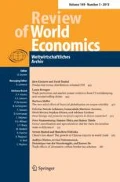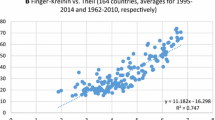Abstract
The paper revisits the relationship between GDP per capita and diversification, using classical and more recent trade theory. Three theoretical findings are presented: (i) competitive models yield predictions only for the extensive product margin; (ii) countries continuously diversify their production and exports—a major controversy in the empirical literature; and (iii) causality runs from diversification to GDP per capita, and not the other way around. The theoretical analysis also provides indication for the appropriateness of alternative measures of diversification, and enables estimating the relationship to economic development in a gravity-type parametric specification. Using detailed data on countries’ exports, the case of re-specialization is rejected. Inference of causality reveals some evidence for GDP per capita affecting the level of diversification, but stronger support for diversification affecting GDP per capita. Generally, both variables are highly endogenous as they are both driven by the technology parameters in standard models of economic growth and international trade.






Similar content being viewed by others
Notes
Note that statistical measures of concentration are inversely related to diversification. The terms specialization and diversification are used as antonyms in this paper, and in the literature.
Agosin et al. (2012) show that sectoral concentration of exports remarkably increased since the 1990s after it had gradually declined during earlier decades. Since most studies cover these years and up to the early 2000s, it is possible that patterns of re-specialization originate from those general trends.
Oil exporters are defined as countries exporting more than 50 % in product categories within HS Chapters 26 and 27. Micro-states are defined as countries with populations below 1 million. These cutoffs were applied to the country averages in order to obtain unambiguous country-specific classifications.
A very similar representation of panel (a) was also used by Bernard et al. (2006). However, they analyzed import competition that arises after the removal of trade barriers for product \(X^{L}\).
In contrast to the classical HO representation, Harrod-neutral technology suggests that capital accumulation and economic growth are driven by technological progress. As a result, the rate of return to capital is constant and equal for all countries while the assumption that \(K/L=\beta Y/L\) is maintained.
Note that the differences in unit prices and factor intensities across source countries might also indicate differences in product quality (Schott 2004).
While the original version of the EK model omits factor endowments, Levchenko and Zhang (2011) provide such an extension. The qualitative implications of the model remain the same.
See Lanati (2013) for alternative approaches to quantify \(\theta \) and the welfare effects.
This follows from the equality \(\pi _{ni}=X_{ni}/X_{i}\), implied by the EK model. \(X_{ni}\) denotes the value of trade flowing from i to n and \(X_{n}\) denotes the importing country’s total expenditure. Aggregation yields \(\sum _{n}X_{ni}/X_{n}=X_{i}/X=\pi _{i}\), which denotes the fraction of goods country i exports world wide.
This is the production function used in the classical Solow (1956) paper, which was emphasized by Gundlach (2007) to generate the Lerner diagram as shown in the previous section. The original EK model considers a production function with labor and traded intermediate inputs, where technology is Hicks-neutral. However, they also refer to Baxter (1992) who derived Ricardian predictions in a setting similar to the one presented here.
For instance, a country’s institutional and legal framework, infrastructure, and other factors that enhance aggregate productivity.
This refers primarily to agricultural products and raw materials which some countries can never export (De Benedictis et al. 2009).
The US data reports 10-digit product codes according to the Harmonized Tariff Schedule nomenclature (HTS). The raw data comprises more than 15,000 distinguishable product lines, but many of them were split up or merged over the years. Application of the algorithm developed by Pierce and Schott (2009) results in 10,640 generic product categories for the years 1992–2009. 3151 were summarized within synthetic categories. The data and the concordance files can be downloaded from http://faculty.som.yale.edu/peterschott/sub_international.htm.
Their count measure \(D_{it}^{A}\) encompasses also agricultural and food products and is based on a constant sample of 4991 HS6 products covering the years 1988–2006.
They apply this threshold to 3-digit bilateral exports data. While the data used here is more disaggregated it considers multilateral trade so it should be applicable also here. For the US import data a threshold of \(\$10,000\) is used to account for the higher level of detail and for bilateral trade.
The HS nomenclature was introduced in 1988 and revised in the years 1996, 2002, 2007, and 2012. BE estimates for each sub-period produced results that were equivalent to those presented here.
Since the purpose of this paper is focussed on the relationship between GDP per capita and export diversification the discussion of trade elasticities is not further expanded and left for future research.
Average annual diversification rates were computet for each country and measure. The sample includes those countries residing in the top quartile of the growth distribution.
Their liberalization data can be downloaded from http://www.anderson.ucla.edu/faculty_pages/romain.wacziarg/papersum.html.
The years surrounding the date of liberalization are fewer in Fig. 6b, because the Comtrade data starts only in 1988. Previous years cannot be taken into consideration. The patters are very similar for all three diversification measures.
The countries are Bulgaria, the Czech Republic, Estonia, Hungary, Latvia, Lithuania, Poland, Romania, the Slovak Republic, Slovenia, and Turkey. Cyprus opened up already in 1960 and Malta’s openness status is not reported in the data.
References
Acemoglu, D., & Zilibotti, F. (1997). Was prometheus unbound by chance? Risk, diversification, and growth. Journal of Political Economy, 105(4), 709–751.
Agosin, M. R., Alvarez, R., & Bravo-Ortega, C. (2012). Determinants of export diversification around the world: 1962–2000. The World Economy, 35(3), 295–315.
Baldwin, R., & Harrigan, J. (2011). Zeros, quality, and space: Trade theory and trade evidence. American Economic Journal: Microeconomics, 3(2), 60–88.
Baxter, M. (1992). Fiscal policy, specialization, and trade in the two-sector model: The return of Ricardo? Journal of Political Economy, 100(4), 713–744.
Bernard, A. B., Jensen, J. B., & Schott, P. K. (2006). Survival of the best fit: Exposure to low-wage countries and the (uneven) growth of US manufacturing plants. Journal of International Economics, 68(1), 219–237.
Bernard, A. B., Moxnes, A., & Ulltveit-Moe, K. H. (2014). Two-sided heterogeneity and trade (NBER Working Papers 20136). Cambridge: National Bureau of Economic Research.
Besedeš, T., & Prusa, T. (2006). Ins, outs, and the duration of trade. Canadian Journal of Economics, 39(1), 266–295.
Cadot, O., Carrère, C., & Strauss-Kahn, V. (2011). Export diversification: What’s behind the hump? Review of Economics and Statistics, 93(2), 590–605.
Cadot, O., Carrère, C., & Strauss-Kahn, V. (2013). Trade diversification, income, and growth: What do we know? Journal of Economic Surveys, 27(4), 790–812.
De Benedictis, L., Gallegati, M., & Tamberi, M. (2009). Overall trade specialization and economic development: Countries diversify. Review of World Economics (Weltwirtschaftliches Archiv), 145(1), 37–55.
Easterly, W., Reshef, A., & Schwenkenberg, J. (2009). The power of exports (Policy Research Working Paper Series 5081). Washington, DC: The World Bank.
Evenett, S. J., & Venables, A. J. (2002). Export growth in developing countries: Market entry and bilateral trade flows. (Mimeo) Department of Economics, Oxford University.
Eaton, J., & Kortum, S. (1999). International technology diffusion: Theory and measurement. International Economic Review, 40(3), 537–570.
Eaton, J., & Kortum, S. (2002). Technology, geography, and trade. Econometrica, 70(5), 1741–1779.
Gould, W. (2001). What is the between estimator? In STATA FAQs, http://www.stata.com/support/faqs/statistics/between-estimator/. Accessed 29 November 2013.
Grossman, G. M., & Helpman, E. (1991). Trade, knowledge spillovers, and growth. European Economic Review, 35(2–3), 517–526.
Grossman, G. M., & Helpman, E. (1993). Innovation and growth in the global economy. Cambridge: MIT Press Books.
Gundlach, E. (2007). The Solow model in the empirics of growth and trade. Oxford Review of Economic Policy, 23(1), 25–44.
Hauck, W., & Wacziarg, R. (2009). A Monte Carlo study of growth regressions. Journal of Economic Growth, 14(2), 103–147.
Hausmann, R., & Rodrik, D. (2003). Economic development as self-discovery. Journal of Development Economics, 72(2), 603–633.
Hausmann, R., Hwang, J., & Rodrik, D. (2007). What you export matters. Journal of Economic Growth, 12(1), 1–25.
Imbs, J., & Wacziarg, R. (2003). Stages of diversification. American Economic Review, 93(1), 63–86.
Kehoe, T. J., & Ruhl, K. J. (2013). How important is the new goods margin in international trade? Journal of Political Economy, 121(2), 358–392.
Klinger, B., & Lederman, D. (2004). Discovery and development: An empirical exploration of “new” products (Policy Research Working Paper Series 3872). Washington, DC: The World Bank.
Klinger, B., & Lederman, D. (2006). Diversification, innovation, and imitation inside the global technology frontier (Policy Research Working Paper Series 3872). Washington, DC: The World Bank.
Koren, M., & Tenreyo, S. (2007). Volatility and development. The Quarterly Journal of Economics, 122(1), 243–287.
Kugler, M., & Verhoogen, E. (2012). Prices, plant size, and product quality. Review of Economic Studies, 79(1), 307–339.
Lanati, M. (2013). Estimating the elasticity of trade: The trade share approach (University of Pisa Working Paper No 159).
Lerner, A. P. (1952). Factor prices and international trade. Economica, 19(73), 1–15.
Levchenko, A.A. & Zhang, J. (2011). The Evolution of comparative advantage: Measurement and welfare implications (NBER Working Papers 16806). Cambridge: National Bureau of Economic Research.
Lucas, R. E. (2009). Trade and the diffusion of the industrial revolution. American Economic Journal: Macroeconomics, 1(1), 1–25.
Mankiw, N. G., Romer, D., & Weil, D. N. (1992). A contribution to the empirics of economic growth. Quarterly Journal of Economics, 107(2), 407–437.
Naito, T. (2014). An Eaton–Kortum model of trade and growth (Discussion Papers No 12055). Research Institute of Economy, Trade and Industry (RIETI)
Parteka, A. (2010). Employment and export specialisation along the development path: Some robust evidence. Review of World Economics (Weltwirtschaftliches Archiv), 145(4), 615–640.
Parteka, A., & Tamberi, M. (2013a). What determines export diversification in the development process? Empirical assessment. The World Economy, 36(6), 807–826.
Parteka, A., & Tamberi, M. (2013b). Product diversification, relative specialisation and economic development: Import export analysis. Journal of Macroeconomics, 38(A), 121–135.
Pierce, J. & Schott, P. (2009). Concording US harmonized system categories over time (NBER Working Papers 14837). Cambridge: National Bureau of Economic Research.
Rodrik, D. (2007). Industrial development: Some stylized facts and policy directions. Geneva: United Nations.
Sachs, J. D., & Warner, A. (1995). Economic reform and the process of global integration. Brookings Papers on Economic Activity, 26(1, 25th A), 1–118.
Schott, P. K. (2003). One size fits all? Heckscher–Ohlin specialization in global production. American Economic Review, 93(3), 686–708.
Schott, P. K. (2004). Across-product versus within-product specialization in international trade. The Quarterly Journal of Economics, 119(2), 646–677.
Schott, P. K. (2008). The relative sophistication of Chinese exports. Economic Policy, 23(1), 5–59.
Solow, R. M. (1956). A contribution to the theory of economic growth. Quarterly Journal of Economics, 70(1), 65–94.
Theil, H. (1972). Statistical decomposition analysis: with applications in the social and administrative sciences. Studies in Mathematical and Managerial Economics, North-Holland Pub: Co.
Tobin, J. (1958). Estimation of relationships for limited dependent variables. Econometrica, 26(1), 24–36.
Wacziarg, R., & Welch, K. H. (2008). Trade liberalization and growth: New evidence. World Bank Economic Review, 22(2), 187–231.
Wooldridge, J. M. (2002). Econometric analysis of cross section and panel data. Cambridge: The MIT Press.
Acknowledgments
The author wants to thank two anonymous referees for their extremely helpful and inspiring comments. The author also wants to thank Michael Funke, Erich Gundlach, Aleksandra Parteka, and seminar participants in Göttingen and Hamburg for their valuable comments and suggestions.
Author information
Authors and Affiliations
Corresponding author
About this article
Cite this article
Mau, K. Export diversification and income differences reconsidered: The extensive product margin in theory and application. Rev World Econ 152, 351–381 (2016). https://doi.org/10.1007/s10290-015-0241-x
Published:
Issue Date:
DOI: https://doi.org/10.1007/s10290-015-0241-x




